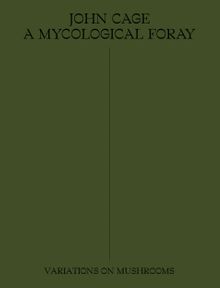| |||||||||||||||||||||||||
ARTIST MONOGRAPHS
|
|
STATUS: Out of stock indefinitely. |
 John Cage: 4'33''– Sounds Like Silence
John Cage: 4'33''– Sounds Like Silence
Silence Today
Published by Spector Books.
Edited with text by Dieter Daniels, Inke Arns. Text by Brandon LaBelle, David Toop, Dörte Schmidt, Julia H. Schröder, Jan Theben. Contributions by Hans-Friedrich Bormann, William Letterman, Kyle Gann, Branden W. Joseph, et al.
John Cage's (1912–92) 4'33" premiered on August 29, 1952, distilling the composer's philosophical explorations of silence into four minutes, thirty-three seconds of performed, charged silence. Elegantly, provocatively, the piece asked: what does silence sound like?
Cage's questions about the nature of silence and sound continue to reverberate decades later; this volume—the most comprehensive on the piece to date—brings together new theoretical writings and artistic works exploring Cage's composition. A wide-ranging list of contributors, contemporary and historical—from Merce Cunningham to Rage Against the Machine—weigh in on Cage's work alongside Cage's original scores and the composer's own subsequent engagements with his most famous piece.
PUBLISHER
Spector Books
BOOK FORMAT
Paperback, 9.5 x 13 in. / 288 pgs / 229 bw.
PUBLISHING STATUS
Pub Date 6/26/2018
Active
DISTRIBUTION
D.A.P. Exclusive
Catalog: FALL 2018 p. 149
PRODUCT DETAILS
ISBN 9783940064417 TRADE
List Price: $40.00 CAD $54.00
AVAILABILITY
In stock
in stock $40.00 Free Shipping UPS GROUND IN THE CONTINENTAL U.S. |
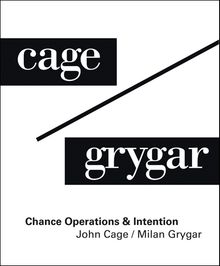 John Cage / Milan Grygar: Chance Operations & Intention
John Cage / Milan Grygar: Chance Operations & Intention
Published by Kerber.
Edited by Beate Reifenscheid. Text by Jean-Yves Bosseur, Hana Larvová, Suzana Leu.
PUBLISHER
Kerber
BOOK FORMAT
Paperback, 9.5 x 11.75 in. / 180 pgs / 62 color / 26 bw.
PUBLISHING STATUS
Pub Date 3/22/2016
Out of print
DISTRIBUTION
D.A.P. Exclusive
Catalog: SPRING 2016 p. 147
PRODUCT DETAILS
ISBN 9783735601551 TRADE
List Price: $47.50 CAD $65.00
AVAILABILITY
Not available
STATUS: Out of print | 00/00/00 For assistance locating a copy, please see our list of recommended out of print specialists |
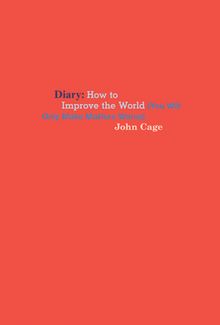 John Cage: Diary
John Cage: Diary
How to Improve the World (You Will Only Make Matters Worse)
Published by Siglio.
Edited by Richard Kraft, Joe Biel.
Typing on an IBM Selectric, Cage used chance operations to determine not only the word count and the application of various typefaces but also the number of letters per line, the patterns of indentation and--in the case of Part Three (published as a Great Bear pamphlet by Something Else Press)--color. The beautiful and unusual visual variances become almost musical as the physicality of the language on the page suggests the sonic. This first complete hardcover edition collects all eight parts Cage originally published in A Year from Monday, M and X. Coeditors Kraft and Biel have consulted these publications along with Cage's original manuscripts, and--with the Great Bear pamphlet as a guide--they have used chance operations to render the entire text in various combinations of red and blue as well as apply a set of 18 typefaces to the entire work.
Composer, philosopher, writer and artist, John Cage (1912-92) is one of the most influential figures of the 20th century. A pioneer in extending the boundaries of music, often composing works through chance operations, Cage also had an extraordinary impact on dance, poetry, performance and visual art.
PUBLISHER
Siglio
BOOK FORMAT
Hardcover, 6 x 8.5 in. / 176 pgs / 145 duotone.
PUBLISHING STATUS
Pub Date 10/27/2015
Out of print
DISTRIBUTION
D.A.P. Exclusive
Catalog: FALL 2015 p. 69
PRODUCT DETAILS
ISBN 9781938221101 TRADE
List Price: $32.00 CAD $42.50 GBP £28.00
AVAILABILITY
Not available
STATUS: Out of print | 00/00/00 For assistance locating a copy, please see our list of recommended out of print specialists |
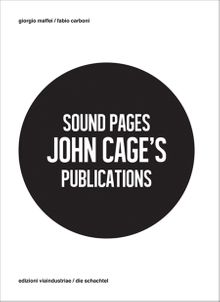 Sound Pages: John Cage's Publications
Sound Pages: John Cage's Publications
Published by Edizioni Corraini.
Edited by Giorgio Maffei, Fabio Carboni.
PUBLISHER
Edizioni Corraini
BOOK FORMAT
Paperback, 5.5 x 7.75 in. / 176 pgs / illustrated throughout.
PUBLISHING STATUS
Pub Date 3/31/2014
Out of stock indefinitely
DISTRIBUTION
D.A.P. Exclusive
Catalog: SPRING 2014 p. 116
PRODUCT DETAILS
ISBN 9788897753032 TRADE
List Price: $39.95 CAD $53.95
AVAILABILITY
Not available
STATUS: Out of stock indefinitely. |
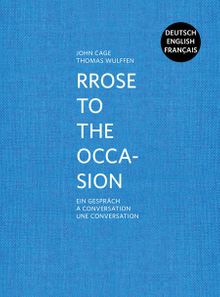 John Cage & Thomas Wulffen: Rrose to the Occasion
John Cage & Thomas Wulffen: Rrose to the Occasion
A Conversation
Published by Moderne Kunst Nürnberg.
PUBLISHER
Moderne Kunst Nürnberg
BOOK FORMAT
Clth, 4.25 x 5.5 in. / 104 pgs / 3 bw.
PUBLISHING STATUS
Pub Date 4/30/2013
Out of print
DISTRIBUTION
D.A.P. Exclusive
Catalog: SPRING 2013 p. 178
PRODUCT DETAILS
ISBN 9783869843858 TRADE
List Price: $25.00 CAD $34.50
AVAILABILITY
Not available
STATUS: Out of print | 00/00/00 For assistance locating a copy, please see our list of recommended out of print specialists |
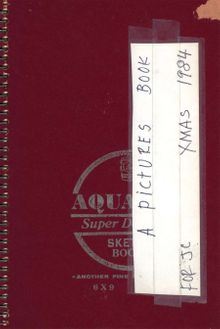 Merce Cunningham: A Pictures Book for John Cage Xmas 1984
Merce Cunningham: A Pictures Book for John Cage Xmas 1984
Published by The John Cage Trust.
PUBLISHER
The John Cage Trust
BOOK FORMAT
Slip, spiralbound, 6 x 9 in. / 80 pgs / 39 color.
PUBLISHING STATUS
Pub Date 5/31/2012
Out of print
DISTRIBUTION
D.A.P. Exclusive
Catalog: SPRING 2012 p. 101
PRODUCT DETAILS
ISBN 9781935202790 TRADE
List Price: $45.00 CAD $55.00
AVAILABILITY
Not available
STATUS: Out of print | 00/00/00 For assistance locating a copy, please see our list of recommended out of print specialists |
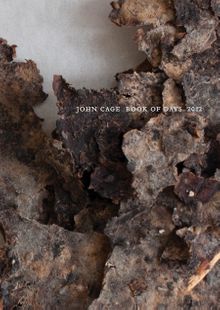 John Cage Book of Days 2012
John Cage Book of Days 2012
Published by The John Cage Trust.
Edited by Laura Kuhn.
PUBLISHER
The John Cage Trust
BOOK FORMAT
Paperback, 4.25 x 6 in. / 120 pgs / 52 duotone.
PUBLISHING STATUS
Pub Date 7/31/2011
Out of print
DISTRIBUTION
D.A.P. Exclusive
Catalog: FALL 2011 p. 56
PRODUCT DETAILS
ISBN 9781935202646 TRADE
List Price: $25.00 CAD $30.00
AVAILABILITY
Not available
STATUS: Out of print | 00/00/00 For assistance locating a copy, please see our list of recommended out of print specialists |
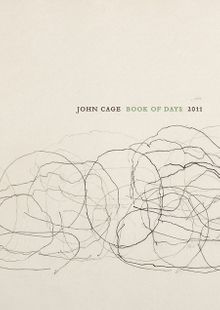 John Cage Book of Days 2011
John Cage Book of Days 2011
2011 Calendar
Published by The John Cage Trust.
Edited by Laura Kuhn.
PUBLISHER
The John Cage Trust
BOOK FORMAT
Paperback, 4.25 x 6 in. / 120 pgs / 26 duotone.
PUBLISHING STATUS
Pub Date 7/31/2010
Out of print
DISTRIBUTION
D.A.P. Exclusive
Catalog: FALL 2010 p. 65
PRODUCT DETAILS
ISBN 9781935202233 TRADE
List Price: $25.00 CAD $30.00
AVAILABILITY
Not available
STATUS: Out of print | 00/00/00 For assistance locating a copy, please see our list of recommended out of print specialists |
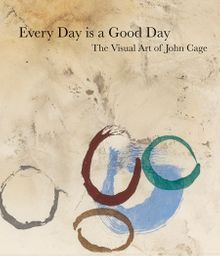 John Cage: Every Day is a Good Day: The Visual Art of John Cage
John Cage: Every Day is a Good Day: The Visual Art of John Cage
Published by Hayward Gallery Publishing.
Introduction by Roger Malbert. Text by Jeremy Millar, Lauren A. Wright, Helen Luckett. Interviews by Kathan Brown, Ray Kass, Laura Kuhn, Julie Lazar, Irving Sandler.
PUBLISHER
Hayward Gallery Publishing
BOOK FORMAT
Paperback, 7.25 x 8.25 in. / 160 pgs / 80 color / 20 bw.
PUBLISHING STATUS
Pub Date 9/30/2010
Out of print
DISTRIBUTION
D.A.P. Exclusive
Catalog: FALL 2010 p. 176
PRODUCT DETAILS
ISBN 9781853322839 TRADE
List Price: $30.00 CAD $35.00
AVAILABILITY
Not available
STATUS: Out of print | 00/00/00 For assistance locating a copy, please see our list of recommended out of print specialists |
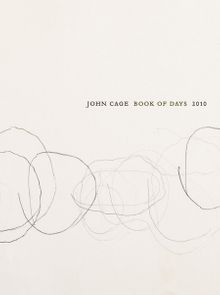 John Cage Book of Days
John Cage Book of Days
2010 Calendar
Published by The John Cage Trust.
Edited by Laura Kuhn.
PUBLISHER
The John Cage Trust
BOOK FORMAT
Paperback, 6 x 4.5 in. / 120 pgs / 52 color.
PUBLISHING STATUS
Pub Date 8/31/2009
Out of stock indefinitely
DISTRIBUTION
D.A.P. Exclusive
Catalog: FALL 2009 p. 107
PRODUCT DETAILS
ISBN 9781935202011 TRADE
List Price: $25.00 CAD $34.50 GBP £22.00
AVAILABILITY
Not available
STATUS: Out of stock indefinitely. |
 Composition in Retrospect
Composition in Retrospect
Published by Exact Change.
By John Cage.
Written in his characteristic “mesostics” (lines of prose poetry linked by a central vertical acrostic), Composition in Retrospect is a statement of methodology in which composer John Cage examines the central issues of his work: indeterminacy, imitation, variable structure and contingency. Finished only shortly before his death in 1992, Composition in Retrospect completes the documentation of Cage’s thought that began with his classic book Silence (1961), but it is an introduction and invitation to his work as much as a summary or conclusion. Also included in this volume (at Cage’s request) is “Themes and Variations,” a piece written in 1982 about friends and heroes such as Jasper Johns, Buckminster Fuller, Marcel Duchamp and Erik Satie. Together these pieces form a book that is both a testament to the artists Cage admired and a clear statement of his own ars poetica.
PUBLISHER
Exact Change
BOOK FORMAT
Paperback, 8 x 6 in. / 184 pgs.
PUBLISHING STATUS
Pub Date 10/1/2008
Out of stock indefinitely
DISTRIBUTION
D.A.P. Exclusive
Catalog: FALL 2012 p. 63
PRODUCT DETAILS
ISBN 9781878972118 TRADE
List Price: $15.95 CAD $22.50 GBP £13.99
AVAILABILITY
Not available
STATUS: Out of stock indefinitely. |
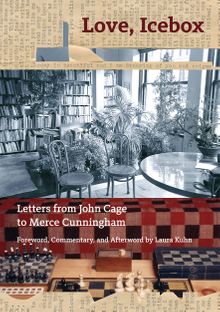 Love, Icebox
Love, Icebox
Letters from John Cage to Merce Cunningham
Published by The John Cage Trust.
Edited with text by Laura Kuhn. Photography by Emily Martin.
A New York Times critics' pick | Best Art Books 2019
These early letters from John Cage to Merce Cunningham will be revelatory, for while the two are widely known as a dynamic, collaborative duo, the story of how and when they came together has never been fully revealed. In the 39 letters of this collection, spanning 1942–46, Cage shows himself to be a man falling deeply in love. When they first met at the Cornish School in Seattle in the 1930s, Cage was 26 to Cunningham’s 19. Their relationship was purely that of teacher and student, and Cage was also very much married.
It was in Chicago that their romantic relationship would begin. Cage was teaching at Moholy-Nagy’s School of Design when Cunningham passed through town as a dancer with the Martha Graham Company, appearing on stage on March 14, 1942. Cage’s letters, which begin in earnest a week later, are increasingly passionate, distraught, romantic and confused, and occasionally contain snippets of poetry and song. They are also more than love letters, as we see intimations that resonate with our experience of the later John Cage.
Love, Icebox takes its shape from these letters—transcribed, chronologically ordered, and in some instances reproduced in facsimile. Laura Kuhn, Cage’s assistant from 1986 to 1992 and now longtime director of the John Cage Trust, adds a foreword, afterword and running commentary. Photographic illustrations of their final 18th Street loft in New York City, as well as personal and household objects left behind, remind us of the substance and rituals of their long-shared life.
PUBLISHER
The John Cage Trust
BOOK FORMAT
Paperback, 6.75 x 9.5 in. / 144 pgs / 96 color.
PUBLISHING STATUS
Pub Date 8/20/2019
Active
DISTRIBUTION
D.A.P. Exclusive
Catalog: FALL 2019 p. 59
PRODUCT DETAILS
ISBN 9781942884385 TRADE
List Price: $24.95 CAD $34.95 GBP £22.00
AVAILABILITY
In stock
in stock $24.95 Free Shipping UPS GROUND IN THE CONTINENTAL U.S. |
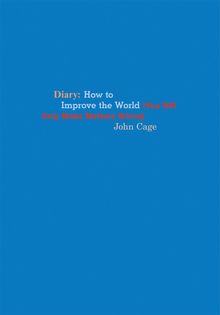 John Cage: Diary
John Cage: Diary
How to Improve the World (You Will Only Make Matters Worse)
Published by Siglio.
Edited by Joe Biel, Richard Kraft. Afterword by David Rose.
Now available in an expanded paperback edition, Diary registers Cage’s assessment of the times in which he lived as well as his often uncanny portents about the world we live in now. With a great sense of play as well as purpose, Cage traverses vast territory, from the domestic minutiae of everyday life to ideas about how to feed the world. He used chance operations to determine not only the word count and the application of various typefaces but also the number of letters per line, the patterns of indentation, and—in the case of Part Three, originally published by Something Else Press—color. The unusual visual variances on the page become almost musical as language takes on a physical and aural presence.
While Cage used chance operations to expand the possibilities of creating and shaping his work beyond the limitations of individual taste, Diary nonetheless accumulates into a complex reflection of Cage’s sensibilities as a thinker and citizen of the world, illuminating his social and political awareness, as well as his idealism and sense of humor: it becomes an oblique but indelible portrait of one the most influential figures of the 20th-century American avant-garde.
Collecting all eight parts into a single volume, coeditors Joe Biel and Richard Kraft also used chance operations to render the entire text in various combinations of red and blue (used by Dick Higgins and Alison Knowles for Part Three) as well as to apply a single set of 18 fonts to the entire work. In the editors’ note, Kraft and Biel elucidate the procedure of chance operations and demonstrate its application, giving readers a rare opportunity to see how the text is transformed.
This expanded paperback edition reproduces the 2015 hardback edition, with a new essay by mycologist and Cage aficionado David Rose and, most important, an addendum that includes many facsimile pages of Cage’s handwritten notebook of a ninth part in progress, bringing the reader into compelling proximity to Cage’s process and the raw material from which Diary was made.
PUBLISHER
Siglio
BOOK FORMAT
Paperback, 5.75 x 8.25 in. / 200 pgs / 24 color / 176 duotone.
PUBLISHING STATUS
Pub Date 10/21/2019
Active
DISTRIBUTION
D.A.P. Exclusive
Catalog: FALL 2019 p. 58
PRODUCT DETAILS
ISBN 9781938221217 TRADE
List Price: $24.00 CAD $31.00 GBP £21.00
AVAILABILITY
In stock
in stock $24.00 Free Shipping UPS GROUND IN THE CONTINENTAL U.S. |
